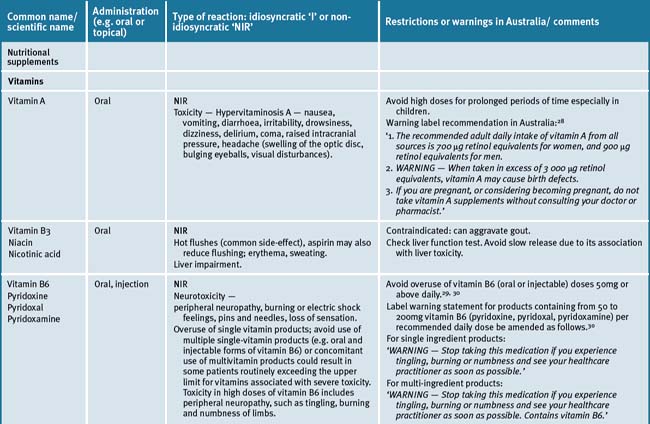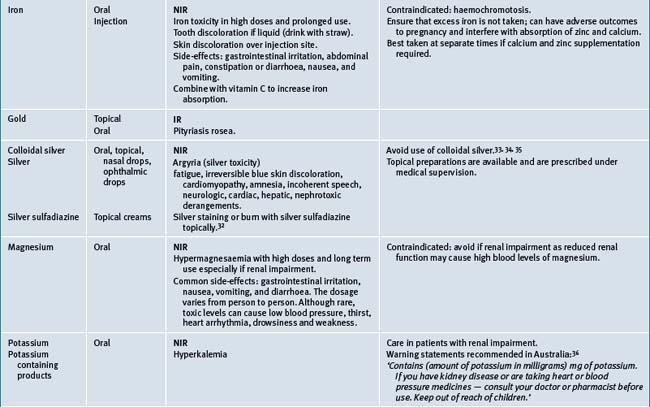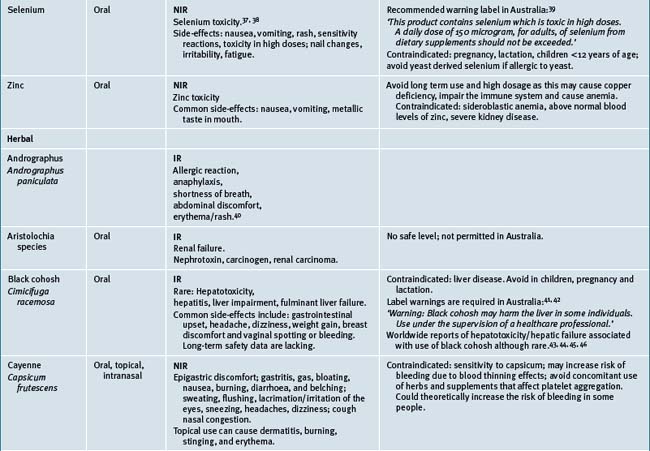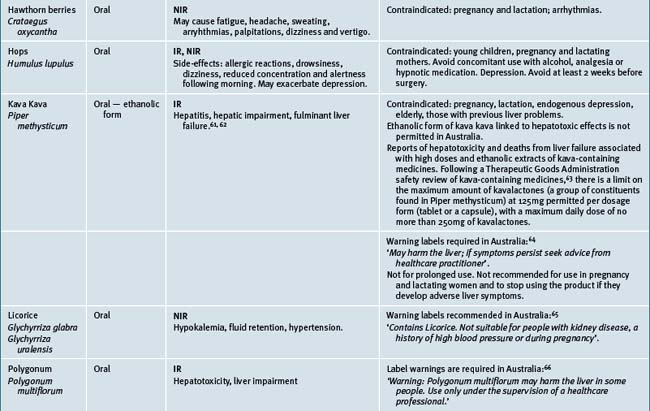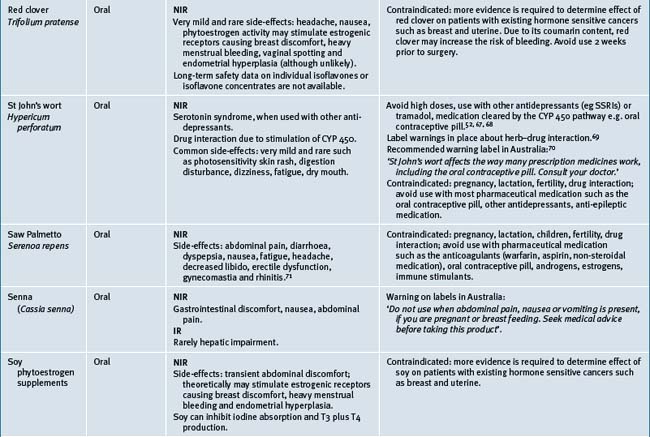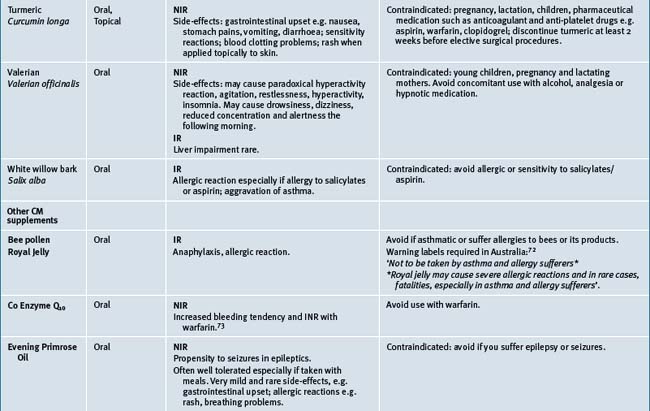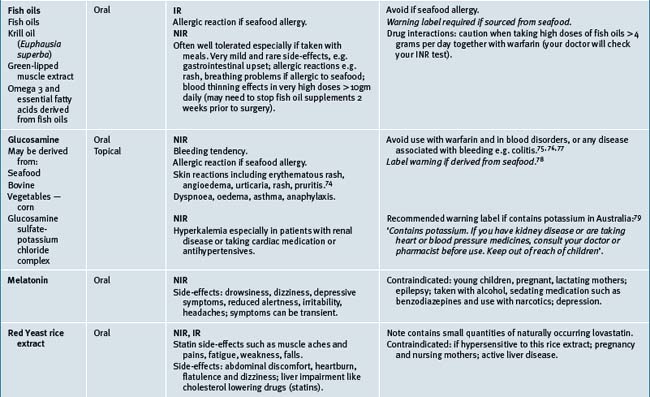Chapter 38 Adverse reactions to complementary medicines (CMs)
Introduction
The definition of adverse drug reaction is defined as a ‘response to a medicine which is noxious and unintended, and which occurs at doses normally used in man’.1 Overall the risk associated with CMs is generally low considering widespread community use. In Australia, the Therapeutic Goods Administration (TGA) define CMs as ‘medicinal products containing herbs, vitamins, minerals, and nutritional supplements, homoeopathic medicines and certain aromatherapy products are referred to as ‘complementary medicines’.2 These are regulated as medicines under the Therapeutics Goods Act 1989i (the Act). CMs also comprise traditional medicines, including traditional Chinese medicines, Ayurvedic medicines and Australian indigenous medicines. See Figure 38.1 for classes of CMs.
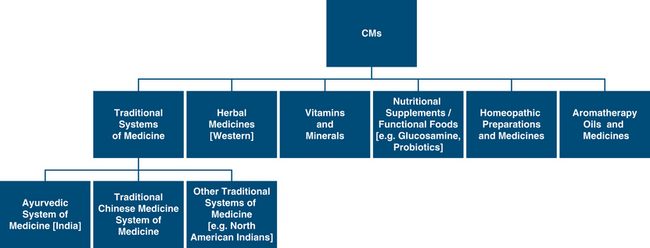
Figure 38.1 Classes of CMs encountered in Australia
(Source: adapted and modified from TGA report http://www.tga.gov.au/DOCS/pdf/cmreport.pdf)
According to the TGA, data from adverse events reported to the Australian Drug Reactions Advisory Committee (ADRAC) arising from the use of listed CMs from 2004 to 2008, for example, shows that there were a total of 656 total reports where a CM was the sole suspected possible, probable or certain cause of an adverse patient reaction, with 7 possible death outcomes associated with a CM. During the same period there were 38 337 cases where a medicine (prescription, over-the-counter medication and other products registered on the Australian register of therapeutic goods (ARTG) included registered rather than listed CMs) was the sole suspected possible, probable or certain cause of an adverse patient reaction, and there were 1014 possible death outcomes.3 In many cases the contribution of the suspected medicine to the death is uncertain, however, based on the information reported it is not possible to entirely exclude the possibility that the suspected medicine contributed to the fatal outcome.
Based on these statistics, the level of reporting for CMs is relatively low compared with pharmaceuticals, considering the widespread usage and the complex diversity of CMs that can be found in Australia, the US and other countries. There may be a number of factors contributing to this, other than having a relatively favourable safety profile (not necessarily efficacy). Other factors include significant under-reporting due to patients failing to communicate adverse events to their medical practitioner and their use of CMs, and medical and allied health practitioners failing to report adverse events to the relevant adverse reporting systems available in each country such as ADRAC in Australia or the FDA in the United States. For example the hepatotoxicity associated with herbal remedies, and naturally occurring plants is extensively under-reported. Hepatotoxicity under-reporting may relate to undetectable subclinical liver disease with mildly abnormal liver chemistry tests thereby endowing many medicinal plants and herbal medicines with a potential for hepatotoxicity with extended use or with overdosing (see Table 38.1).
Table 38.1 Hepatotoxicity of medicinal plants and herbal medicines
| Potentially hepatotoxic | Unlikely hepatotoxic |
|---|---|
| Ackee fruit Mediterranean glue thistle/Atractylis gummifera Azadirachta indica Bajiaolian Berberis vulgaris Black cohosh/Cimicifuga racemosa Impila/Callilepsis laureola Camphor Cascara sagrada Carp gallbladder Senna/Cassia angustifolia Greater celandine/Chelidonium majus Chinese herbal medicines Cocaine/Erythroxylon coca Sassafras/Sassafras albidum |
Chamomille/Anthemis nobilis
Cranberry/Vaccinium macrocarpon
Dandelion root/Taraxacum Officinale
Feverfew/Tanacetum parthenium
Garlic/Allium sativum
Ginger/Zingiber Officinale
Gingko Biloba
Ginseng/Panax ginseng
Goldenseal/Hydrastis canadensis
Peppermint/Mentha piperita
St John’s Wort/Hypericum perforatum
Saw Palmetto/Serenoa repens
(Source: adapted and modified from Steadman,5 Chiturri & Farrell,6 Ernst,7 Teschke et. al.,8 and Schiano9)
Knowledge of CM adverse reactions
From the Australian National Prescribing Service (NPS) study, it is clear there is an urgent need for medical practitioners such as General Practitioners to learn more about adverse reactions with CMs.4 About 40% of general practitioners reported having minimal or no knowledge about black cohosh and ginkgo biloba, and less than 40% of the surveyed GPs were aware of some potential side-effects and drug–CM interactions of ginkgo biloba, glucosamine and black cohosh.4 Only 38% of GPs were aware that black cohosh has been linked to liver damage despite an ADRAC report published in 2005.2, 10 This highlights a concern that needs to be addressed through better education about risks associated with CMs and the need to report adverse reports for CMs, especially as there is widespread community use with up to one-quarter of Australians using at least 1 medicinal herb and two-thirds are using some form of CM within the last 12 months of national surveys.11, 12
Types of adverse reactions
Pharmacodynamic versus pharmacokinetic reactions
Medicine interactions can also be described as pharmacodynamic or pharmacokinetic. Pharmacodynamic reactions are usually complex where medicines can interfere with absorption, metabolism by enzymes such as cytochrome P450 and renal excretion affecting another medicine. Pharmacokinetic interactions involve additive of similar medicines or a cancelling effect.13
Common interactions
Most common potential interactions were for pharmaceuticals: aspirin, warfarin, ticlodipine, plus CMs: garlic, gingko, glucosamine, or fish oil potentially resulting in increased risk of bleeding.14
Extemporaneous herbs such as Ayurvedic and Traditional Chinese Medicine may be contaminated by heavy metals such as lead, arsenic and mercury, potentially causing metal toxicity15–18 or contaminated with pharmaceuticals such as steroids or hormones, particularly those imported from overseas countries that have poor regulatory guidelines.19
For more detailed information about herb–nutrient–drug interactions, please refer to Chapter 37. A number of papers have explored potential herb drug interactions but adequate research and understanding in this area is still lacking.20–25
Risk factors for adverse reactions
It is important to note that elderly, children, pregnant and lactating women may respond differently to adverse reactions as the physiology and metabolism varies with their weight, age, and many other factors that affect medication dosages.26 The elderly are particularly prone to adverse reactions as they are more likely to suffer a comorbid disease such as a chronic disease, have some degree of renal and hepatic impairment, low muscle mass, are prone to dehydration especially at times of suffering diarrhoea, and are often taking other medication which puts them at higher risk of herb–drug interactions. Adverse reactions can also be determined by genetic differences which explain why some populations are more prone to reactions. This is known as pharmacogenetics. This phenomenon is recognised with pharmaceuticals but not well recognised with CMs to date.27
Table 38.2 summarises likely adverse reactions reported in the literature and to adverse reporting bodies for CMs at the time of writing this chapter.
Reporting adverse events
It is imperative that all health practitioners (medical and non-medical) report any suspected adverse reactions or interactions to medicines/pharmaceuticals, including CMs, over-the-counter medicines, any traditional or alternative remedies and vaccines, including those suspected of causing death, hospital admission, requiring more treatment and investigations or suspected birth defects if a mother takes a medicine during pregnancy.80 These reports are analysed by experts using the World Health Organization (WHO) causality assessment algorithm to determine level of causality of a suspected medicine(s) (see Who algorithm below). Reporting of adverse reactions provides information that can be gathered for any emerging medicine safety issues and allows further action in each country or internationally to be taken if necessary. Action may include restricting use of the medicine or enforce relevant label warnings and for media alerts to warn the community of concerns.
Reporting systems are in place in many developed countries. These are summarised in Table 38.3.
| Country and publications | Mechanism for reporting |
|---|---|
| Australia Medicines Safety Update (having replaced ADRAC bulletins) in Australian prescriber regularly report common or serious adverse reactions to CMs. To subscribe, go to: www.tga.gov.au/adr/msn/msu1006.htm |

